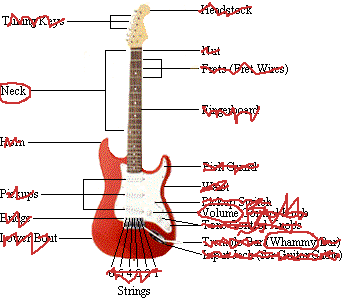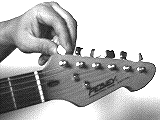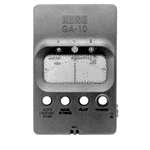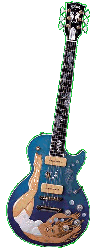
THE COMPLETE GUIDE TO THE GUITAR FOR THE BEGINNER TO INTERMEDIATE TO ADVANCED PLAYER.

leon bambrick
(Note for Advanced players: just scroll past all the stuff at the start)
Part 1 - The Guitar
 The guitar is basically your six-stringed kind of
instrument, which violinists may recognise as being a bit bigger than a violin, and rather
more 'womanly' in shape. That would be an acoustic guitar. But electric guitars (and
here's where the fun really starts!) can come in all kinds of shapes, such as the flying
V.
The guitar is basically your six-stringed kind of
instrument, which violinists may recognise as being a bit bigger than a violin, and rather
more 'womanly' in shape. That would be an acoustic guitar. But electric guitars (and
here's where the fun really starts!) can come in all kinds of shapes, such as the flying
V.
The guitar can be played either left handed or right handed, standing up or sitting down
the difference being in the way that it is played, and also the strings.
Part 2 - Basic Chords
The most basic chords are termed "Major chords" - not because of the military
rank of the same name (ha ha ha - you'd better get used to my jovial sense of humour if
you're gonna read this whole thing!!!) but because they include the "major notes in
the scale". "Hang on!?" I hear you say. "whooooooah! what's this about
'major notes in the scale??' You've gone all technical on us Leon" Well I guess
you're more of a beginner than i thought so let's side track ourselves with the history of
music.
Part 2a - the Complete History of Music
The oldest musical instrument is arguably the human voice, unless our ancestor monkeys were particularly melodic farters. Drums probably came next - though not Zildjian drums!! More likely just some dumb shit ape whacking a club against his enemies head. And soon after that came the Heptatonic Major Form. This is a seven note scale which goes from the root note (for example in the key of "C", the root note is called "C" and in the key of "B" the root note is called "B" .... here's a comprehension question - what's the root note in the key of "H"?? If you said "H" then that's a nice try, but the correct answer was "There's no such thing as the key of H, you dickhead, Leon!!" ) in one octave right up to the root note in the next octave.
Within any note you will find that there are in-fact
several notes or 'waveforms' playing or 'resounding'- musicians call these 'harmonics', as
does everyone else i guess. The harmonics are what give the note its tonality and also
what helped our ancestors to define the Heptatonic Major Form. Now get out your guitar, if
you have one (or a ruler and a textbook if you don't) because we're gonna do some
practical exercises in musical theory!!
Part 3 - Practical Exercises in musical theory.
For right handed guitarists only:
 Push the index finger of your left hand against one of
the strings of the guitar until it touches the fretboard, behind one of the frets.
This is called "pushing down a string." It doesn't matter which string or which
fret you choose, the name is still the same, but hopefully you chose one of the lower
sounding frets or you'll completely fuck up this next exercise. Use your plectrum (held in
the right had between thumb and index finger) to pluck the string you are pushing. Listen
very carefully to the note produced. Now try wiggling your left index finger as you pluck
the string - this form of vibrato is sometimes called 'wiggling your finger'. Now try
stretching the string as you pluck it, by pushing it vertically along the fret. This is
called bending the string. You can bend by one semi-tone (one fret's tonal difference) or
by two semitones, or as jimi hendrix used to often do, seven semi-tones. Yes, and his
strings used to break just like that as well. Now choose a different string and a
different fret. Now move your 'fretting finger' (index finger left hand) higher up the
fret board, along the same string until you've travelled a distance of TWELVE frets. Now
pluck it again. Uncanny isn't it? It's the bass line out of 'Careful With That
Axe Eugene'
by Pink Floyd - you're first song! Notice however that it may be in a different key to the
original because it has been transposed, or as guitarists say 'shifted', to a randomly
selected key, or as guitarists say 'thingo'.
Push the index finger of your left hand against one of
the strings of the guitar until it touches the fretboard, behind one of the frets.
This is called "pushing down a string." It doesn't matter which string or which
fret you choose, the name is still the same, but hopefully you chose one of the lower
sounding frets or you'll completely fuck up this next exercise. Use your plectrum (held in
the right had between thumb and index finger) to pluck the string you are pushing. Listen
very carefully to the note produced. Now try wiggling your left index finger as you pluck
the string - this form of vibrato is sometimes called 'wiggling your finger'. Now try
stretching the string as you pluck it, by pushing it vertically along the fret. This is
called bending the string. You can bend by one semi-tone (one fret's tonal difference) or
by two semitones, or as jimi hendrix used to often do, seven semi-tones. Yes, and his
strings used to break just like that as well. Now choose a different string and a
different fret. Now move your 'fretting finger' (index finger left hand) higher up the
fret board, along the same string until you've travelled a distance of TWELVE frets. Now
pluck it again. Uncanny isn't it? It's the bass line out of 'Careful With That
Axe Eugene'
by Pink Floyd - you're first song! Notice however that it may be in a different key to the
original because it has been transposed, or as guitarists say 'shifted', to a randomly
selected key, or as guitarists say 'thingo'.
 For left handed
guitarists:
For left handed
guitarists:
Do the same thing as the right-handed guitarists but do it back-to-front.
Part 4 - Expanding your repertoire
Having mastered the art of playing a note you might want to move on to "Riffing".
A RIFF is a short piece of music which you never get of sick no matter how many times you play it or hear it.
The first Riff I am going to teach you is from the Cream classic 'Sunshine Of Your Love'. This riff requires a great deal of patience and you shouldn't expect to master it for at least a few years yet. In the tradition of over six million guitarists world wide this should be the first riff you learn, closely followed by smoke on the water. If however your guitar teacher/guru is born after 1980, then he or she will force you to start with a Kurt Cobaine tune or some Jeff Buckley nonsense. This is what many guitarists refer to as 'The Passing of the Golden Age of Guitar'.
The riff out of 'Sunshine of your love' however goes like this:
---12--12--10-12----7-----6-----5-----0--3------0---
and can be played on any string and in a variety of ways.
Note: If the tablature above looks like crazy jargon to you then you may want to peruse The Quick & Pocket-Sized Guide To Standard Guitar Tablature Notation.
If you want to play 'Sunshine Of Your Love' on more than one string, or in a different way, then it is probably a good idea to learn about the tuning of your guitar. For that reason, the next section is called 'How to Tune Your Guitar' so I recommend that would-be rock guitarists skip to the section after that.
 Part
5 - How to Tune Your Guitar
Part
5 - How to Tune Your Guitar
Buy a tuner and ask your girlfriend to learn how to use it. If you can't afford either of these then ask either a roadie or the band playing after you to tune the guitar for you. Never ask the band playing before you to tune your guitar because this is considered a terrible faux pas since it destroys the age old myth of billing order being directly related to a band's worthiness. In any case the band playing after you will feel very flattered and superior, having been asked to tune your guitar for you and will proudly hand it over to the roadie to do along with their own guitars.
The strings, highest to lowest (or bottom to top) should end up like this: E,B,G,D,A,E - unless you are a user of marijuana in which case the expected tuning is F#,Bb,Gb, Gb, A#,E#.
Now you've got your guitar in tune, you've learnt all about musical theory and there's a few riffs under your belt you're probably ready to tackle some of the big issues such as looking good, sounding great and pulling chicks in with your big new guitar look. But first up we'll have to explore the wide wide world of guitar accessories.
 Part
6 - Accessories after the
fact
Part
6 - Accessories after the
fact
The most fundamental accessory to a guitar is a 'strap' which is used for holding the guitar up when you are standing, and avoids having to do the embarrassing and dorky looking duck knee squat. You can wear your guitar strap short or long depending if you want to be dignified though gay, or just a typical wanky guitarist respectively. You can get straps that have interesting folky colours woven into them or ones with cross bones. They both hold the guitar up, so it's all down to personal taste I guess.
A 'plectrum' or 'guitarists pick' is a funky little piece of merchandise that can set you back a good wad of cash if you're dumb enough to shell out for an expensive one. But here's a free tip that can save you a pretty penny: just steal them from the local music shop like everyone else. The guys who work there are too busy showing off their guitar licks to easily impressed college girls to ever notice, so don't be shy.
A 'capo' is another accessory which is useful for allowing you to play in any key without learning anything other than open chords, and it lets you fuck around between songs a bit longer on stage, particularly if you're too drunk to read the set list. If you can't sing and play a song in tune in the key in which it was written, then a capo can help you to not sing it in tune in a great many other keys as well.
One of the most under-utilised accessories in classical music is certainly the whammy bar. The whammy bar, as the name doesn't suggest is a skinny little metallic phallic symbol which allows the guitar to come as close to masturbation as is physically possible without actually making a mess. Many famous guitarists have employed the whammy bar to successfully make their guitar solos just that smidgen wankier than was ever thought possible.
Pedals are a guitarist's best friend. Any mistake you can make can be perfectly hidden by your pedal, as long as you have the right setup. The 'right setup' is a serial connection of fifteen or more pedals, in any order. If uncertain about what to play, just stomp down on the next pedal and try to synchronise it with a power chord. The windmill arm, invented by Pete Townshend of 'Who' is certainly recommended.
Amplifiers come in many different style and types, there being two main schools of thought in the world of 'amps' as they are known. One school says that amps should be as big as possible and the other says as loud as possible. both groups advocate as much noise as possible, the schools being called 'tube' and 'transistor' respectively. James Marshall Hendrix was an advocate of Fender guitars, and, strangely, Marshall amps. If you share a middle name with an amplifier manufacturer, then that might be a good starting point for you as well.
Part 7 - Philosophy and the Guitar
Guitars and philosophy go together like groupies and venereal disease. Playing guitar is the most relaxing pursuit in the world except maybe fly fishing; those guys can get pretty laid back. And meditation too, I guess that's more relaxing. Oh and smashing your guitar, that's very therapeutic as well, though I don't know that the term 'relaxing' would really apply.
You must always remember that your guitar is like a lover to you. She is special. She is curvy and makes you feel nice. A guitar must be treated with respect and a guitar must be cherished and loved, not physically, cause that's sick, but spiritually, with all your heart. It is like that John Lee Hooker song, made extra memorable from the popular George Thoroughgood cover version, 'Treat Her Right'. "You'll be glad every night, if you just treat her right. Da-na-na-na-na." That reminds me of a good friend of mine who used to always say that all the best philosophical lessons in life can be learned from listening to rock n roll music. Good Old Roger 'Rambo' Ramboney was his name and he was full of good philosophies until that tiger got him.
Part 8 - Live long and prosper!
Well, I'm afraid that that is really all you need to know about guitar. After that it's just practice, practice, drugs, touring, burn-out and bad Bob Dylan covers. How far you go with your guitar is limited only by your imagination and the number of fingers and hands you have, so best of luck... and until next time "Keep On Fretting!"
 Having trouble learning chords? why not
learn bass instead?
Having trouble learning chords? why not
learn bass instead?
Want to perfect that big fat hillbilly sound? Why not try banjo?
As tone deaf as a plank and with a brain like rotten cheese? Drums are for you!
Would you like to advertise at this popular and
informative site? Email me with your ideas: ![]() Leon Bambrick
Leon Bambrick
Coming Soon
The Complete Tablature Archive of World Music From the Dawn Time Until The Next Ten Thousand Years! Now includes The Beatles! Plus over one dozen bands!
Meanwhile:
head to:
The Quick & Pocket-Sized Guide
To Standard Guitar Tablature Notation ![]()
The Complete Custard Tablature Archive
Or see the rest of this site:
copyright leon bambrick 1999-2003